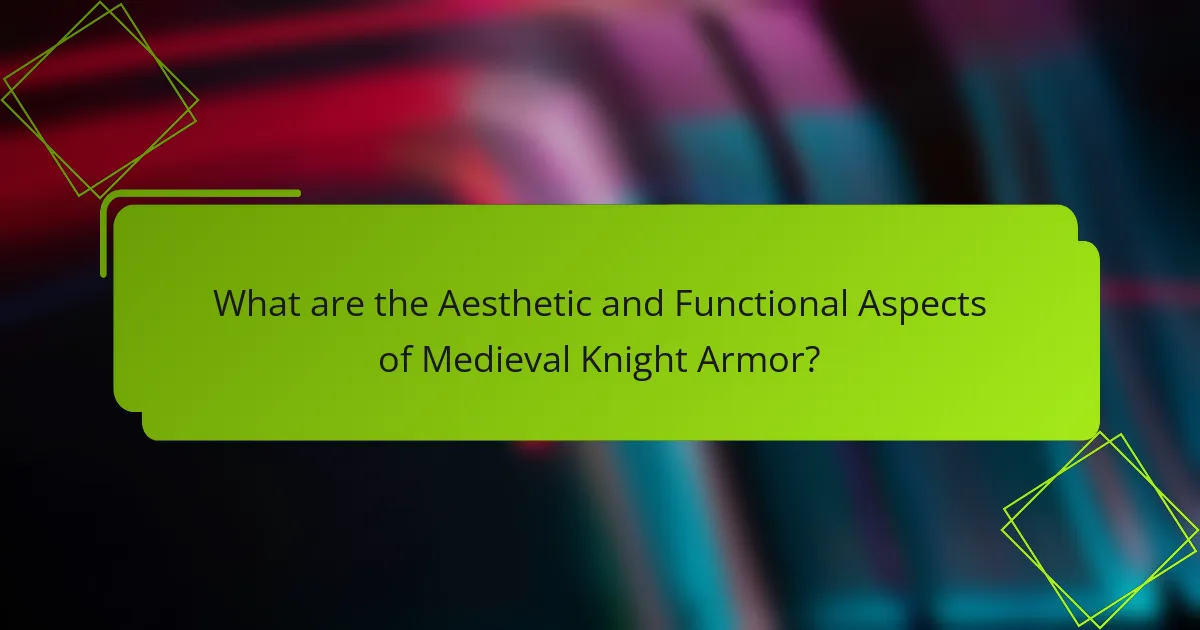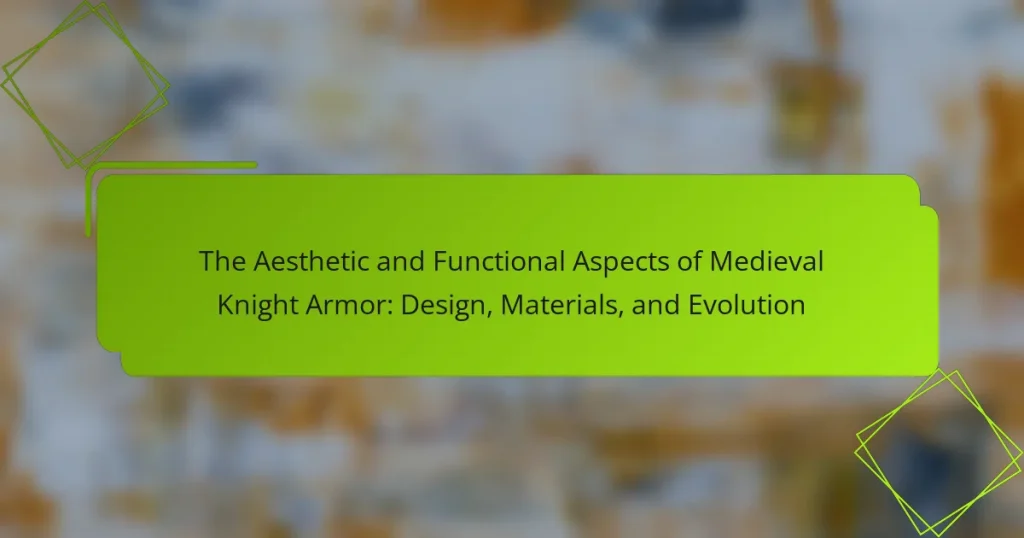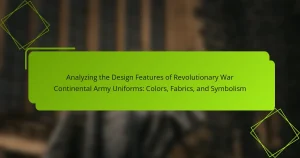Medieval knight armor is a significant artifact that served both aesthetic and functional purposes during the Middle Ages. The armor featured elaborate designs, including engravings and colorful heraldry, reflecting the wealth and status of the knight. Functionally, it provided essential protection in battle, crafted from durable materials like iron and steel, with designs that allowed for mobility while safeguarding vital areas. Key components of knight armor included the helmet, breastplate, gauntlets, and greaves, each serving specific protective roles. The evolution of armor mirrored advancements in metallurgy and combat strategies, influencing modern protective gear and continuing to shape cultural representations in films and historical reenactments.

What are the Aesthetic and Functional Aspects of Medieval Knight Armor?
Medieval knight armor served both aesthetic and functional purposes. Aesthetically, armor was often elaborately designed to display wealth and status. Decorative elements included engravings, etchings, and colorful heraldry. These features made armor visually striking and symbolized the knight’s identity and lineage.
Functionally, armor provided essential protection in battle. It was crafted from materials like iron and steel, which offered durability against weapons. The design included articulated joints for mobility while ensuring coverage of vital areas. Specific forms, such as plate armor, emerged to enhance defense against projectiles.
Historical evidence shows that the evolution of armor reflected advancements in metallurgy and combat strategies. By the late Middle Ages, full plate armor became common, demonstrating a balance between protection and mobility. The dual focus on aesthetics and functionality made medieval knight armor a significant aspect of chivalric culture.
How did design influence the effectiveness of knight armor?
Design significantly influenced the effectiveness of knight armor by enhancing protection and mobility. Armor design evolved to include articulated joints and layered materials. These features allowed knights to move freely while maintaining defense against weapons. The shape of armor also directed blows away from vital areas. For example, the rounded surfaces of plate armor deflected strikes. Additionally, the weight distribution in armor improved balance and agility. Historical evidence shows that well-designed armor increased survivability in battles. Overall, design played a crucial role in maximizing both protection and functionality for knights in combat.
What design elements were essential for protection in battle?
Essential design elements for protection in battle included materials, coverage, mobility, and reinforcement. Armor was typically made from metals like steel or iron for durability. It covered vital areas such as the torso, head, and limbs. The design allowed for mobility, enabling knights to move effectively. Reinforcements were added at joints and vulnerable points to enhance protection. Historical examples include the full plate armor of the 15th century, which provided comprehensive coverage. The evolution of armor design reflects advancements in metallurgy and battlefield tactics. These elements collectively ensured a balance between protection and functionality in combat scenarios.
How did aesthetics play a role in the perception of a knight’s status?
Aesthetics significantly influenced the perception of a knight’s status. The visual appeal of armor showcased wealth and craftsmanship. Intricate designs and embellishments indicated a knight’s social standing. Knights with ornate armor were often viewed as more prestigious. The materials used, such as gold or silver, further elevated their status. Historical records show that elaborate armor was a mark of nobility. A knight’s appearance in battle could inspire awe and fear. Overall, aesthetics served as a visual language of hierarchy and power in medieval society.
What materials were commonly used in the construction of knight armor?
Knight armor was commonly constructed using materials such as iron, steel, and leather. Iron was often used for its availability and strength. Steel provided improved durability and resistance to impact. Leather served as a flexible layer for comfort and protection. In addition, chainmail made from interlinked metal rings offered mobility and defense against slashing attacks. Some armors also incorporated padding made of cloth or wool for additional cushioning. Historical records indicate that these materials were essential in creating effective protective gear for knights during battles.
What were the advantages and disadvantages of different materials?
Different materials used in medieval knight armor had distinct advantages and disadvantages. Steel provided excellent protection and durability, making it the preferred choice for many knights. However, steel was heavy, which could limit mobility. Leather was lighter and allowed for greater flexibility, but it offered less protection against weapons. Chainmail provided a balance between protection and weight, but it could still be penetrated by sharp weapons. Plate armor offered superior defense but was expensive and required skilled craftsmanship. Each material’s effectiveness depended on the context of use, such as the type of combat and the knight’s role in battle.
How did the choice of materials affect the weight and mobility of the armor?
The choice of materials significantly impacted the weight and mobility of armor. Lighter materials, such as leather or chainmail, allowed for greater agility. In contrast, heavier materials like plate steel increased protection but restricted movement. Historical evidence shows that knights preferred a balance between weight and defense. For instance, the transition from chainmail to plate armor was aimed at improving defense while managing weight. Modern analyses indicate that the average weight of full plate armor ranged from 40 to 60 pounds. This weight distribution affected how knights maneuvered in battle, influencing their effectiveness. The choice of materials was crucial in designing armor that met both aesthetic and functional needs.
How did the evolution of knight armor reflect changes in warfare?
The evolution of knight armor reflected changes in warfare by adapting to new combat strategies and technologies. Initially, armor was primarily made of chainmail, which offered flexibility and protection against slashing attacks. As warfare evolved, particularly with the rise of heavy cavalry and crossbows, plate armor emerged to provide better defense against penetrating strikes. The introduction of gunpowder weapons in the 15th century necessitated further innovations. Armor became heavier and more articulated to protect against bullets while allowing for mobility. By the late medieval period, armor designs included elaborate decorative elements, reflecting the status of the knight and the shift towards individual combat. The changes in armor corresponded directly to advancements in weaponry and tactics, illustrating the dynamic relationship between armor design and the nature of warfare.
What historical events influenced the design and functionality of armor?
The design and functionality of armor were influenced by several historical events. The fall of the Roman Empire led to the need for protection against invading forces. The rise of feudalism increased the demand for armored knights in battle. The Crusades introduced new combat techniques and materials, prompting armor evolution. The Hundred Years’ War saw advancements in armor design for better mobility and defense. The introduction of firearms in the 15th century forced armor makers to adapt to new threats. Each of these events shaped armor’s development, reflecting the changing nature of warfare and technology.
How did advancements in technology impact armor development?
Advancements in technology significantly influenced armor development throughout history. Innovations in metallurgy allowed for stronger and lighter materials. The introduction of steel in the late medieval period replaced earlier iron, enhancing durability. Improved forging techniques enabled the creation of more complex shapes and designs. The invention of the crossbow necessitated stronger armor to protect against piercing projectiles. Gunpowder weapons later led to the development of plate armor that could withstand bullets. Additionally, advancements in design, such as articulated joints, improved mobility for knights. These technological changes ultimately shaped the effectiveness and aesthetics of armor in medieval warfare.

What are the key components of Medieval Knight Armor?
The key components of Medieval Knight Armor include the helmet, breastplate, gauntlets, and greaves. The helmet protects the head and often includes a visor for visibility. The breastplate covers the torso, providing vital protection against weapons. Gauntlets shield the hands while allowing for dexterity in combat. Greaves protect the lower legs from injury. Additional components may include shoulder plates, arm guards, and chainmail for flexibility. These elements worked together to provide comprehensive protection for knights in battle during the medieval period.
What types of armor were commonly used by knights?
Knights commonly used several types of armor throughout the medieval period. The most prevalent forms included chain mail, plate armor, and brigandine. Chain mail consisted of interlinked metal rings, providing flexibility and protection against slashing attacks. Plate armor evolved later, featuring large metal plates that covered vital areas of the body, offering superior defense against blunt force and piercing weapons. Brigandine was made of a fabric base with small metal plates riveted to it, balancing mobility and protection. Historical records indicate that these armor types were essential for knights during battles and tournaments, as they significantly increased survivability.
What is the difference between plate armor and chainmail?
Plate armor consists of large, solid metal plates that cover the body. It provides superior protection against blunt force and cutting attacks. Chainmail, on the other hand, is made of interlinked metal rings. It offers flexibility and effective defense against slashing attacks. Historically, plate armor emerged in the late Middle Ages, while chainmail was used earlier, dating back to the Roman era. The weight distribution in plate armor allows for greater mobility despite its heft. Chainmail is lighter but can be cumbersome due to its design. Both types of armor served distinct purposes in medieval warfare, reflecting advancements in combat techniques and materials.
How did the layering of armor enhance protection?
Layering of armor enhanced protection by distributing the force of impacts across multiple surfaces. This design reduced the likelihood of [censured] by weapons. Each layer absorbed and deflected blows effectively. Historical examples show that layered armor was more resilient against arrows and swords. For instance, plate armor combined with chainmail provided both rigidity and flexibility. The combination allowed knights to maintain mobility while ensuring safety. Additionally, overlapping layers minimized gaps that could be exploited by enemies. Overall, this strategic construction significantly improved the survivability of the wearer in combat.
How did the fit of armor affect a knight’s performance?
The fit of armor significantly affected a knight’s performance. Properly fitted armor enhanced mobility and agility. It allowed knights to maneuver effectively in battle. Conversely, ill-fitting armor restricted movement and caused fatigue. Historical records indicate that knights with well-fitted armor could maintain stamina during prolonged combat. For example, the Battle of Agincourt in 1415 showcased the importance of mobility. Knights who were encumbered by heavy, poorly fitted armor struggled against more agile opponents. Overall, the fit of armor was crucial for maximizing a knight’s combat effectiveness.
What techniques were used to ensure a proper fit?
Medieval knight armor was fitted using several techniques to ensure proper fit. Tailoring techniques included measuring the knight’s body dimensions accurately. Artisans crafted armor in layers to accommodate movement. They utilized adjustable straps and buckles for customization. This allowed for individual adjustments based on the wearer’s physique. Additionally, some armor featured articulated joints for enhanced flexibility. The use of materials like leather and chainmail contributed to a snug fit. Historical records indicate that armor fitting was a meticulous process, often requiring multiple fittings. These techniques ensured both comfort and protection during combat.
How did custom armor designs cater to individual knights?
Custom armor designs catered to individual knights by providing tailored protection and personal expression. Each suit of armor was crafted to fit the specific measurements of the knight, ensuring comfort and mobility. Artisans considered the knight’s height, weight, and fighting style during the design process. This customization allowed for better maneuverability in battle. Additionally, armor could be adorned with unique emblems or heraldry, reflecting the knight’s identity and status. Historical records show that famous knights often commissioned specific designs that showcased their lineage. The use of custom materials also enhanced both protection and aesthetic appeal. Overall, custom armor was essential for blending functionality with personal significance.

What are the lasting impacts of Medieval Knight Armor on modern society?
Medieval knight armor has significantly influenced modern society in various ways. Its design principles are evident in contemporary protective gear, such as motorcycle and sports equipment. The materials used in armor, like steel and leather, have inspired modern manufacturing techniques. Additionally, medieval armor has shaped the aesthetics of modern fantasy and historical films, influencing costume design. The symbolism of chivalry and honor associated with knights continues to permeate popular culture. Furthermore, historical reenactments and museums preserve the legacy of knight armor, educating the public about its historical context. This influence reflects the ongoing fascination with medieval history and its artifacts.
How does medieval armor influence contemporary fashion and design?
Medieval armor influences contemporary fashion and design through its aesthetic elements and structural features. The intricate designs of armor, such as embellishments and patterns, inspire modern clothing aesthetics. Designers often incorporate metal accents and structured silhouettes reminiscent of armor into their collections.
Additionally, the layering techniques used in armor inform contemporary fashion, promoting the use of layered garments for both style and functionality. Historical references in fashion often draw from the visual language of armor, including the use of corsets and structured bodices.
Furthermore, contemporary costume design for films and theater frequently utilizes armor as a reference point for character attire. The materials used in medieval armor, such as leather and chainmail, have also influenced modern fabric choices in fashion.
Overall, the legacy of medieval armor is evident in the way contemporary fashion blends historical references with modern design principles.
What elements of knight armor can be seen in modern protective gear?
Modern protective gear incorporates several elements of knight armor. Helmets are a direct descendant, offering head protection. Body armor, such as vests, reflects the breastplates of knights. Gauntlets are similar to modern gloves that protect the hands. Shin guards and knee pads echo the leg protection found in knight armor. The use of layered materials in modern gear mimics the construction of historical armor. Additionally, the concept of mobility in design is shared between the two. Both aim to balance protection and movement efficiency.
How has the portrayal of knights in media shaped public perception of armor?
The portrayal of knights in media has significantly shaped public perception of armor. Films, television shows, and literature often depict knights in shining, elaborate armor, emphasizing their nobility and valor. This representation creates an idealized image of armor as both protective and aesthetically pleasing.
Such portrayals often overlook the practicality and functionality of armor used during medieval times. For instance, historical accuracy shows that armor was designed for combat efficiency, not just visual appeal. Documentaries and historical texts reveal that armor evolved based on warfare needs, materials available, and technological advancements.
The romanticized image of knights in media influences modern interpretations of armor in popular culture. Video games and fantasy novels continue to draw from these portrayals, reinforcing the notion that armor is synonymous with heroism and adventure. This leads to a skewed understanding of armor’s historical context and practical use in battle.
Overall, media representations have created a lasting impact on how society views armor, often prioritizing aesthetics over historical accuracy.
What practical tips can be applied when studying Medieval Knight Armor?
Examine primary sources such as manuscripts and artifacts for accurate study of Medieval Knight Armor. Analyze the design features and materials used in different periods. Focus on the evolution of armor styles across regions. Study historical texts for context on armor functionality in battle. Attend reenactments or museums to observe armor in person. Utilize academic journals for in-depth research on specific armor types. Collaborate with experts in medieval history for insights. Document findings systematically to build a comprehensive understanding.
How can enthusiasts effectively research historical armor techniques?
Enthusiasts can effectively research historical armor techniques by utilizing a combination of primary and secondary sources. Primary sources include historical texts, manuscripts, and artifacts that provide direct evidence of armor construction and use. Secondary sources consist of scholarly articles, books, and documentaries that analyze and interpret these primary materials.
Visiting museums with armor collections can offer hands-on experience with the artifacts. Engaging with historical reenactment groups allows enthusiasts to learn practical applications of armor techniques. Online databases and academic journals also provide access to research studies focused on armor technology and design.
For instance, the book “Medieval Armor: The Knight’s Armor of the Middle Ages” by David Nicolle offers detailed insights into construction techniques and materials used in historical armor. Additionally, the journal “Archaeological and Anthropological Sciences” features studies that analyze the materials and methods used in armor production.
What resources are available for those interested in armor reconstruction?
Resources for those interested in armor reconstruction include books, online forums, and workshops. Books such as “The Medieval Armor Reconstruction Handbook” provide detailed guides on techniques and materials. Online forums like the Armor Archive allow enthusiasts to share knowledge and experiences. Workshops and events, such as the annual Armored Combat League gatherings, offer hands-on learning opportunities. Museums often have resources or workshops focused on historical armor. Additionally, academic journals on medieval studies publish research relevant to armor reconstruction. These resources collectively support individuals in learning about and practicing armor reconstruction.
The main entity of this article is medieval knight armor, which encompasses both its aesthetic and functional aspects. The article explores the design, materials, and evolution of knight armor, highlighting how aesthetics showcased a knight’s status while functionality provided essential protection in battle. Key topics include the influence of design on effectiveness, the materials used in construction, and the historical events that shaped armor development. Additionally, it discusses the impact of armor on modern society, including its influence on contemporary fashion and protective gear. The article provides a comprehensive overview of how medieval knight armor reflects advancements in warfare and technology.




